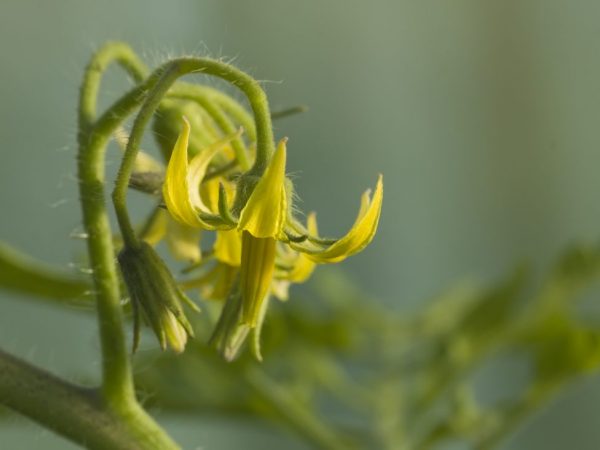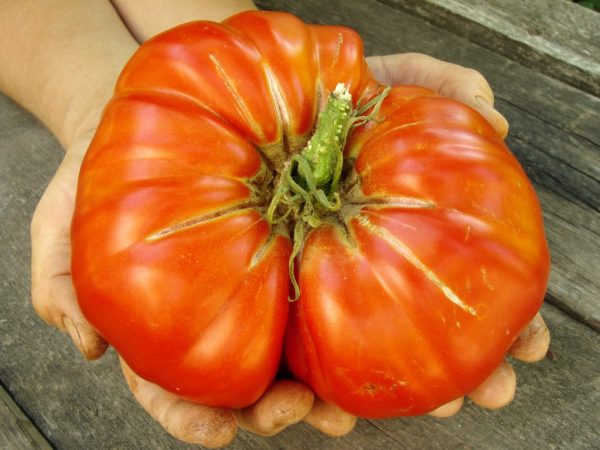Double flowers on tomatoes
Tomatoes are one of the most common crops. Their seedlings are relatively unpretentious, but prone to a number of diseases, one of which is the double flowers on tomatoes.

Double flowers on tomatoes
Reasons for the formation of double flowers
The traditional type of tomato bloom is small inflorescences of yellow star-shaped flowers with 5 petals and stamens. But sometimes asymmetrical giant flowers (2-3 times larger than usual) with an excessive number of stamens, sepals and petals are formed on the first flower cluster. Because of their unusual appearance, these flowers are called terry, or royal. The usual place of their formation is the lower tier of a bush of large-fruited varieties (Volovye Serdtse, Rosy Gigant, Marmande, etc.).
In scientific language, the process of formation of such giant flowers is called fasciation. Fasciation is inherent not only in tomatoes, it covers various plants, both cultivated and wild.
There are 2 reasons for the formation of double flowers:
- adverse changes in the growing environment;
- viral diseases.
It is very easy to determine the cause of the fascial culture: with a viral disease, the entire plant will be covered, and not just individual flowers. In most cases, royal flowers are formed due to a sharp change in conditions for the worse. These include:
- temperature changes;
- fluctuations in air humidity;
- insufficient soil moisture.
Fasciation is the fusion of several flowers with each other, therefore, the fruits from them are formed fused, very large, ribbed, irregular and often ugly in shape.
Options for Fasciation
There are 2 options for the formation of double flowers:
- removal of accrete flowers;
- plucking out the rest of the flowers in the brush.
The basis for the choice is the gardener's goal: a regular crop or giant fruits.
Removing fasciaed flowers
For a tomato bush, royal flowers are a negative factor for the following reasons:
- fruits from such inflorescences inhibit flowering and the formation of the second wave of ovaries on the brush, because ripen much longer than ordinary tomatoes;
- giant tomatoes form nutrient deficiencies for other fruits, which is why crop yields are markedly reduced.
Usually, there are few fasciated flowers on the bush, so their removal has little effect on the overall yield.
Growing fasciated fruits

A double flower can make a giant fruit
From accreted flowers, abnormally large fruits are formed. The qualitative characteristics of such a tomato can vary from low seeds and juiciness to thick walls and almost complete absence of pulp, therefore, such fruits are grown in rare cases, mainly in order to obtain record large tomatoes.
Growing fasciaed tomatoes has specific requirements:
- removal of the rest of the ovaries on the hand to reduce the outflow of nutrients to other fruits;
- application of an increased amount of organic and mineral fertilizers.
For good nutrition of the giant tomato, it is recommended to mulch the root zone of the bush with wood ash, especially before loosening. Every 2 weeks, gardeners recommend applying fertilizers, alternating mineral and organic.
Additional roots can be another source of nutrients. For their formation, it will be useful to plant bushes in special holes, which are gradually filled with soil.
Prevention of fasciation
The main viral diseases that provoke the development of fasciation include:
- tomato mosaic;
- bronze (spotted wilting);
- complex streak (combination of several viruses at once).
The peculiarity of virus infection is that the plant cannot be cured and is a source of threat of damage to other seedlings.
Prevention of viral infections is the use of healthy planting material and fertilizers, disinfection of equipment and tools, timely removal of diseased plants.
Tatiana Orlova (Candidate of Agricultural Sciences):
The vectors of tomato viral diseases are insects - mainly aphids and leafhoppers. And the reserves of the virus are wild weeds, such as field bindweed. Therefore, it is important to deal with weeds in your area and with their vectors.
To obtain a healthy harvest, it is necessary to create favorable growing conditions. Mandatory to prevent splicing of flowers are:
- building a soft amplitude of the change in daily air temperature;
- creating an optimal level of humidity in the air and root soil.
Tatiana Orlova (Candidate of Agricultural Sciences):
This is only possible in protected ground conditions - temperature and humidity control. Outdoors, weather is a given that you have to put up with.
Conclusion
Terry flowers on a tomato are an indicator of the health of a plant. Fasciated tomatoes require an increased influx of nutrients and minerals, which inhibits the growth of other fruits and leads to a decrease in the yield of the bush. Therefore, gardeners in most cases recommend removing accrete ovaries to obtain a high-quality uniform harvest.
Tatiana Orlova (Candidate of Agricultural Sciences):
It is not recommended to take seeds from the fruits of fasciated tomatoes, because the likelihood of the appearance of the same fruits in subsequent generations is high.



